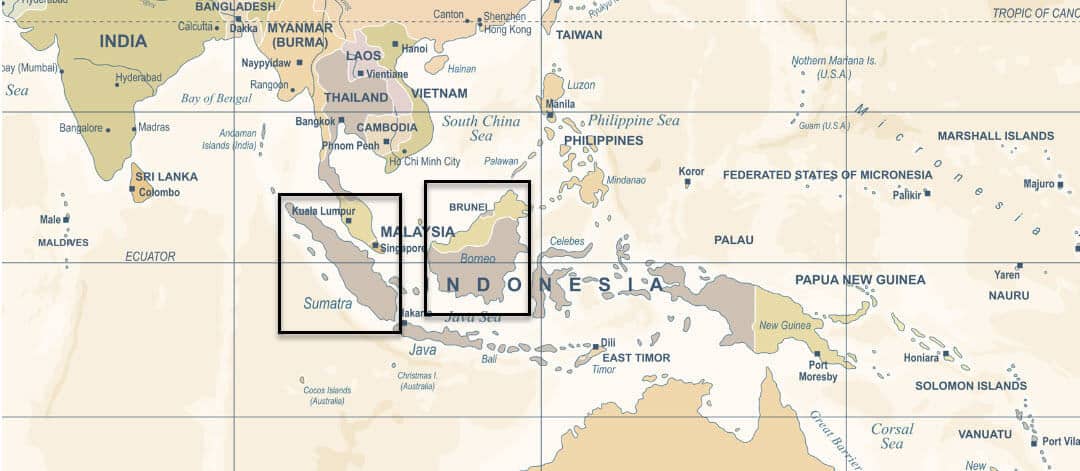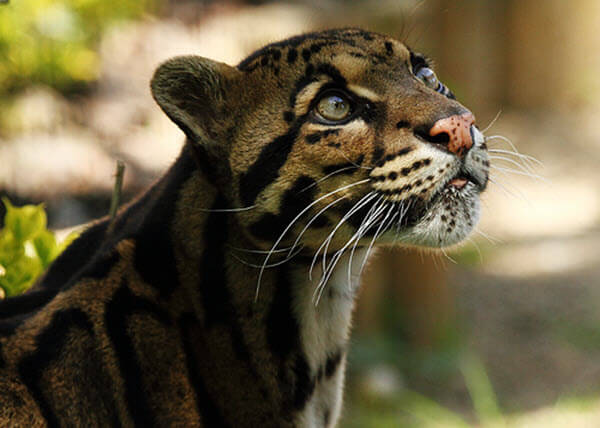The Sunda clouded leopard, also known is a medium-sized wild cat inhabiting the Indonesian islands of Sumatra and Borneo.
Scientific Name: Neofelis diardi
Conservation Status: Vulnerable, decreasing population.
Subspecies:
- Neofelis diardi diardi (Sumatran clouded leopard)
- Neofelis diardi borneensis (Bornean clouded leopard)
Meaning of the Name: The word leopard is a compound of “leo” (lion) and “pardus” (panther). Clouded leopard refers to the spots on the cat’s fur that look like clouds. Sunda is in reference to the regional name Sunderland.
Population: Estimated at less than 10,000, with a suggested total of 4,500 mature individuals, with around 3,800 in Borneo and 730 in Sumatra.
Interesting Sunda Clouded Leopard Facts
- The Sunda clouded leopard is also known as the tree or branch tiger. In Indonesia, it is called “macan-dahan” which means “branch tiger”.
- Their fur is darker and greyer with smaller blothces and thier black margins that the clouded leopard.
- Their markings are smaller than a clouded leopard
- It has long canine teeth, which, relative to its skull, are longer than those of any other living cat.
- The Sunda clouded leopard’s tail can grow as long as its body.
- Can jump up to 4 feet high.
More about Sunda Clouded Leopards
Sunda clouded leopards inhabit Sumatra and Borneo in Indonesia. Borneo is politically divided into three countries: Malaysia and Brunei in the north and Indonesia in the south.
The Clouded leopard is usually found in hilly and forested areas. Less than 10,000 Sunda clouded leopards are estimated to live in the wild.
Origin and history
Clouded leopards are members of the Pantherinae subfamily, along with lions, tigers, jaguars, leopards and snow leopards. It is believed that Sunda clouded leopards from Borneo established a population in Sumatra during the Late Pleistocene period when the sea level was lower and a land bridge existed between the two islands.
The clouded and Sunda clouded leopard is an evolutionary link between big cats and small wild cats.
For a long time, the clouded leopard was considered a single species. IN 2006, after additional research and DNA analysis, the clouded leopard was separated into two species, the Indochinese clouded leopard (Neofelis nebulosa) and the Sunda clouded leopard (Neofelis diardi).
Clouded leopards are not closely related to leopards.
Physical appearance
The Sunda clouded leopard has a stocky appearance with short legs. It weighs between 26 and 55 lbs. and is considered a medium-sized cat compared to other wild cats.
The Sunda clouded leopard has long teeth—around 2 inches long—and a long tail. Its greyish fur has unevenly shaped oval markings with dark edges, similar to the shape of a cloud, which is why it is called a “clouded” leopard. The cat’s markings are smaller and less vibrant than the Indochina clouded leopard.
Where Sunda clouded leopards live
Sunda clouded leopard inhabits two large islands in Indonesia – Borneo and Sumatra.
In Borneo, the cat can be found in forests below 5,000 ft.
In Sumatra, the cat inhabits somewhat hilly and mountainous areas. They have been seen in the Bukit Barisan Selatan, Kerinci Seblat and Gunung Leuser national parks, which make up the Tropical Rainforest Heritage of Sumatra, an Indonesian World Heritage Site.

Sunda Clouded Leopard Behavior
Sunda clouded leopards usually lead solitary lives. They are mostly active at night and sometimes during the day if there are no large cats in the area.
They mark their territory with scent – urine, feces and scraping dirt with their back feet.
The Sunda clouded leopard is a highly skilled climber. Its short legs and big paws make it easy for it to climb trees, hang upside down and come down the tree head first.
Hunting and diet
Sunda clouded leopard prey includes deer, pigs, civets, monkeys, porcupines, and fish. The cat is believed to hunt mainly on the ground, but will climb trees to hunt and escape danger.
They will sometimes prey on domestic livestock, which can result in retaliatory killing (human-wildlife conflict).
Reproduction and lifespan
Sunda clouded leopards can mate at any time of the year, but it is most common between December and March. One male mates with multiple females. Females can produce a litter every year.
The gestation period for female Sunda clouded leopards is 85-95 days. They usually give birth to 1-5 cubs, with an average of 2 cubs per litter.
Newborn cubs are born helpless, with their eyes closed and no teeth. Their eyes open at 10-14 days, and teeth appear around three weeks.
Cubs are usually weaned at 90-100 days and become independent at 1.5-2 years. The males do not help raise the kittens.
They reach reproductive maturity at two years old.
The lifespan of a wild Sunda clouded leopard is estimated to be between 11 to 17 years.
Sunda Clouded Leopard Conservation
A key conservation issue for the Sunda clouded leopard is habitat loss due to deforestation
Experts believe that as much as 50% of lowland forests have been lost in the region over the past ten years due to new settlements. An increase in oil palm plantations has also caused forest destruction.
Even though the cat is protected in Indonesia, Malaysia, and Brunei, illegal trade is another threat. The cat’s skin and body parts are used in Asian medicine.

Sunda Clouded Leopard in Culture
Borneo shamans and warriors wear clouded leopard pelts. In some areas, the petls are also ceremonial clothing.
Research Quotes
“In Sabah (a state of Malaysia located in northern Borneo), Sunda clouded leopard decline is directly attributed to low population density, habitat loss and fragmentation, hunting and indirect snaring, pet trade and road development (such as the Pan Borneo Highway that would lead to an increase of road kills).” – 2018 Sunda Clouded Leopard Action Plan for Sabah |Sabah Wildlife Department
“…hunting area for sunda clouded leopard was an area with dense canopy cover (64,67%). Resting area and cover area for sunda clouded leopard were areas with very dense canopy cover (78,64% and 73,43%).”– 2023 HABITAT CHARACTERISTIC OF SUNDA CLOUDED LEOPARD (Neofelis diardi Cuvier 1823) IN BATUTEGI PROTECTION FOREST LAMPUNG | Malik, Hernowo et al.

